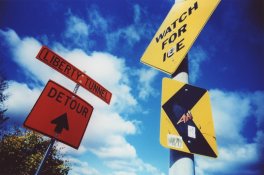Ever see those highly saturated shots made by big laser printers from slides? It's generally the same CAII paper you can use with your enlarger. And optical prints are capable of just as much dye saturation as the digital ones. In fact, you might get better results. But there is
obviously a different workflow, and there is more to it than just wiggling a mouse of punching a keyboard. I've placed gloss Fuji RA4 prints
side by side with Cibachromes, and people couldn't tell the difference. Of course, a white versus black border is a dead giveaway; but in
terms of the image colors per se, they couldn't discern a loss in impact. Now I'm not commending overtly saturated colors, and personally
hate it when photographers can't differentiate between color and "colorful" in the sense of sheer visual noise. This is just an example of how flexible certain RA4 papers can be in a darkroom setting. Most photographers have just forgotten a lot of tricks, or just want to be lazy
and not learn any advanced printing skills. That's fine. You can take this stuff as far as you wish. But it's an utter myth that digital workflow is inherently superior, or leads to superior results, visually. It just works in a different manner, and in this point in history is getting to be the only convenient way to print chromes, via scanning. But when it come to working with color neg film, scanning and post processing actually introduces certain unnecessary potholes. But learning to do anything well takes some commitment.











